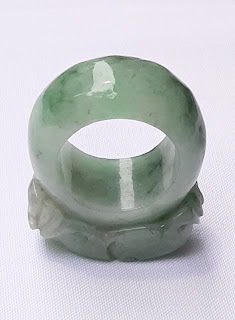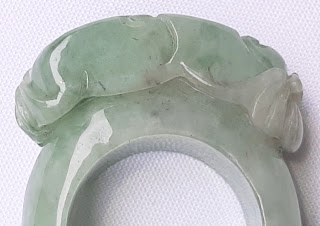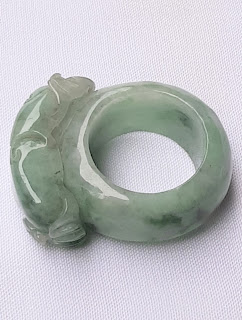清朝乾隆時期冰種三彩綠彩飄藍花及一點紫翡翠巧雕成春蠶(㝢意腰纏萬貫且萬貫家財)帶超美夢幻紫羅蘭眼睛馬鞍扳指
Qing Dynasty Qianlong period ice type tricolor green and blue colors with a violette dot jadeite cleverly carved archery thumb saddle ring with a spring silkworm (meaning to be extremely rich in wealth and have a wealthy family) having a super beautiful dreamy violet eye as ring's saddle
https://youtu.be/9MRE1TRAznM?si=ticnzfDK59HOQF7A
https://youtu.be/hURhEd9OGqQ?si=zemiHUqCRRoVolUm
重量: 32 公克
比重: 3.3 (翡翠比重)
尺寸: 全高 4.2 x 寬 1.3 X 內圈直徑 2.1 x 外圈直徑 3.1 x 厚 0.5 厘米 cm
馬鞍尺寸:長 3.2 x 寬 1.3 x 厚 0.9 厘米 cm
Weight: 32 grams
Specific gravity density: 3.3 (The specific gravity density of jadeite)
Dimensions: Total Height 4.2 x Width 1.3 x Inner ring diameter 2.1 x Outer ring diameter 3.1 x Thickness 0.5 cm
Dimensions of Saddle: Length 3.2 x Width 1.3 x Thickness 0.9 cm
此翡翠扳指係來源所有人陳俊英女士 ( 1932 - ) 的父親陳萬承是明朝洪武十八年 (公元 1385 年) 被明朝皇帝朱元璋封為軍事大元帥的先祖陳秀甫的第 20 代後裔。
清朝的扳指在統治階層非常流行,分為文扳指和武扳指,文扳指是文臣佩戴,講究材質珍貴、工藝複雜和外觀美麗,武扳指則是武臣佩戴,在工藝和外觀上並不講究,通常素面無紋,而此翡翠扳指是個文扳指。
清代各種規制日趨完善,扳指雖小卻也是森嚴等級的一種象徵,多以玉石、翡翠、瑪瑙、珊瑚等名貴材料製作的扳指,非皇室貴冑一般人是不敢也不能隨意佩戴的。普通旗人佩戴的扳指,以白玉磨製者為最多,貴族扳指則以翡翠質料者為上選。
清朝諸位帝王對翡翠扳指喜愛有加,因而盛極一時,達官貴人喜歡將之戴在手指摩挲,流露出地位、權利、富貴和氣質,遂成為身分地位的表徵。紀曉嵐在《閱微草堂筆記》中記載,翡翠因其美麗稀有,在乾隆朝早期到中晚期短短五、六十年間,即從鮮為人知的玉材一躍而上,價值超過和闐美玉,成為「玉石之王」。然上等質地翡翠不需再施雕琢,以翡翠本身天然成色取勝。故本件翡翠馬鞍扳指係冰種三彩綠彩飄藍花及一點紫,不但外觀高貴迷人,並且明顯係由清朝乾隆皇室的精湛雕刻工藝所精心製作,亦將一點紫巧雕成扳指馬鞍上春蠶之帶超美夢幻的紫羅蘭眼睛,真是精美無比,是為上品中的極品。
腰纏萬貫這一寓意也是與蠶的諧音相關,「蠶」與「纏」讀音類似,「纏」令人聯想到腰纏萬貫與萬貫家財。
把價值美金八百萬元的翡翠扳指套在拇指上,究竟是何種感覺呢?
This jadeite carved archery thumb ring is attributed to the owner, Ms. Chen Junying (1932-), whose father, Chen Wancheng, was the 20th generation descendant of ancestor Chen Xiufu. Chen Xiufu was nominated as military generalissimo by Emperor Zhu Yuanzhang of the Ming Dynasty in the 18th year of Hongwu period in the Ming Dynasty (AD 1385).
The Qing Dynasty's archery thumb ring was very popular among the ruling class people. It was divided into civil archery thumb ring and military archery thumb ring. Civil archery thumb ring was worn by civil servants and paid attention to precious materials, complex craftsmanship and beautiful appearance. Military archery thumb ring was worn by military officials and was not particular about craftsmanship and appearance. The surface of military archery thumb ring is usually plain and has no patterns. This jadeite carved archery thumb ring is a civil archery thumb ring.
In the Qing Dynasty, various regulations were gradually perfect. Although the archery thumb ring was small, it was also a symbol of strict hierarchy. Archery thumb rings were mostly made of jade, jadeite, agate, coral and other precious materials. Most people who were not members of the royal family and nobles did not dare and could not wear them casually. The archery thumb rings worn by ordinary bannermen are mostly made of white jade, while the archery thumb rings worn by nobles are made of jadeite as the best selection.
The emperors of the Qing Dynasty were very fond of jadeite carved archery thumb rings, so they became very popular for a while. Dignitaries liked to wear them on their fingers and rub them, revealing status, power, wealth and temperament, and it became a symbol of status. Ji Xiaolan recorded in "Notes of Yuewei Thatched Cottage" that due to its beauty and rarity, jadeite jumped from a little-known jade material to a value exceeding that of Khotan jade in just 50 to 60 years from the early to the middle upto late Qianlong period of dynasty, and became the "King of Jade". However, high-quality jadeite does not need to be carved, and the natural color of the jadeite prevails itself. This jadeite archery thumb saddle ring is ice type tricolor green and blue colors with a violette dot. Not only does it look noble and charming, but it is also clearly made with the exquisite carving techniques of the Qianlong imperial workshop of the Qing Dynasty. A dot of violette is also skillfully carved as a beautiful dreamy violet eye of the spring silkworm that is the ring's saddle. It is truly exquisite and is the best of the best.
The meaning of having waist-entangled with a wealth of money is also related to the homophony of silkworm. The pronunciation of "silkworm" is similar to that of "entangled". "Silkworm" reminds people of having been waist-entangled with a wealth of money to be extremely rich in wealth and to have a wealthy family.
How does it feel to put an eight million US dollars' jadeite carved archery thumb ring on your thumb?
Works of Art
Provenance:
Ms. Chen Junying (1932- ). Her father Chen Wancheng was the 20th generation descendant from the ancestor Chen Xiufu [Official name: Guangludafu, an official who was close to the Emperor, and acted according to the edict of the Emperor, also the founding hero of the Ming Dynasty, from Wuhua, Guangdong.], who was nominated as the military Marshal by Ming Emperor Zhu Yuanzhang in Hongwu 18th year (1385 A.D.) Ming Dynasty. She has inherited the family handed-down ancestral collection, including valuable ceramics, jade carved works of art, antiques, bronzes, and Chinese paintings moving from mainland China to Taiwan since Qing dynasty, from her father Chen Wancheng and has been trained to be a good professional collector and an excellent appraiser by family education since childhood for over 80 years.
Chen Xiufu
Official name: Guangludafu, an official who was close to the Emperor, and acted according to the edict of the Emperor, also the founding hero of the Ming Dynasty, from Wuhua county, Guangdong Province, China.
Chen Xiufu was nominated as the military Marshal by Ming Emperor Zhu Yuanzhang in Hongwu 18th year (1385 A.D.) Ming Dynasty.
http://www.nanchens.com/xqxx/xqxx32/xqxx32510.htm
https://www.xuehua.tw/a/5ec8742f868e1a463e412f06
https://ppfocus.com/0/cu4cb061d.html
藝術品
來源:
陳俊英女士 ( 1932 - )。她的父親陳萬承是明朝洪武十八年 (公元 1385 年) 被明朝皇帝朱元璋封為軍事大元帥的先祖陳秀甫 (明代開國功臣光祿大夫 [為皇帝近臣依皇帝詔命行事] 陳秀甫 [廣東五華籍]) 的第 20 代後裔。她從父親陳萬承處繼承了家族傳世的祖傳藏品,包括自清朝以來從中國大陸移至台灣的珍貴陶瓷器、玉器、古董、青銅器和中國書畫,她自童年開始透過家庭教育,即被培養成為一位很棒的專業收藏家和優秀的鑑賞家已達 80 多年。
陳秀甫
陳秀甫是明代的開國功臣光祿大夫 [此官名為皇帝近臣依皇帝詔命行事],中國廣東省五華縣人。
明朝洪武十八年 (公元 1385 年) 陳秀甫被明朝皇帝朱元璋封為軍事大元帥。
http://www.nanchens.com/xqxx/xqxx32/xqxx32510.htm
https://www.xuehua.tw/a/5ec8742f868e1a463e412f06
https://ppfocus.com/0/cu4cb061d.html
%206000%20(1).png)
%206000%20(1)%20(1).png)

















































































%206000%20(2)%20(1).png)